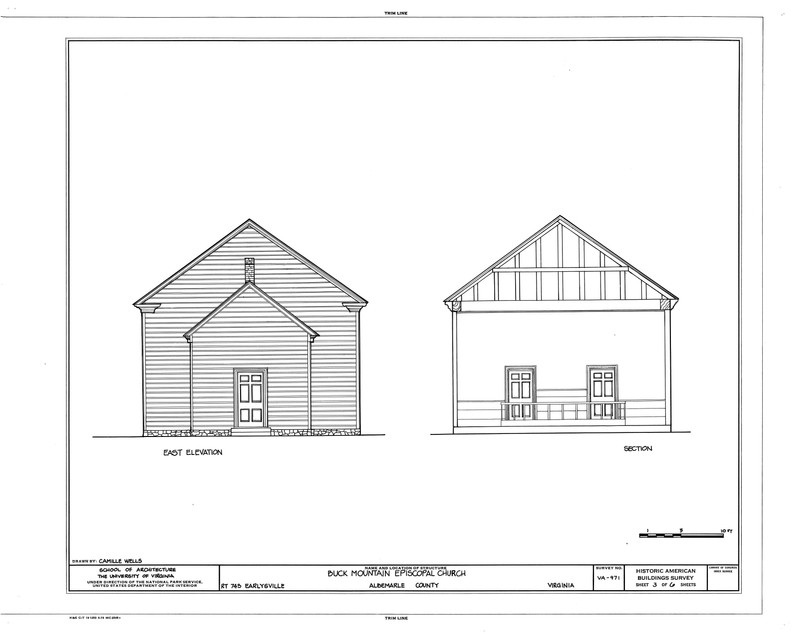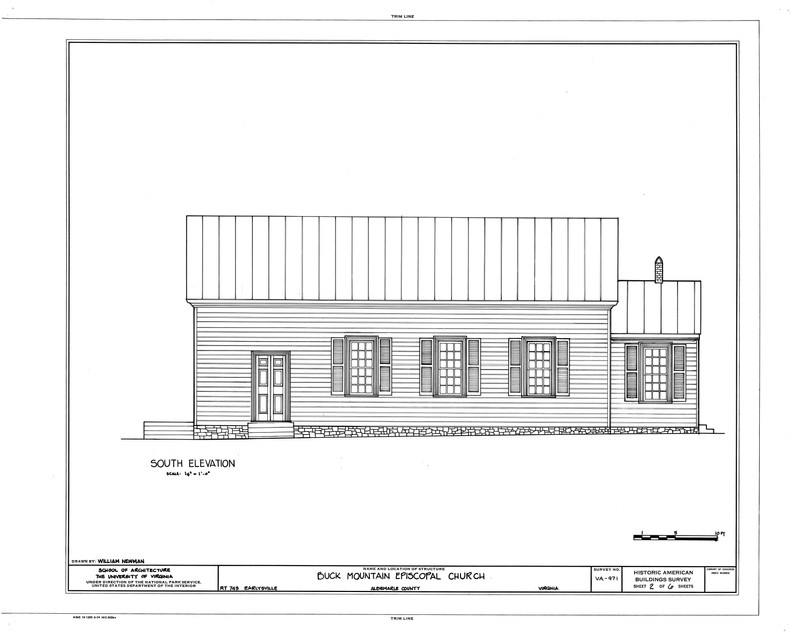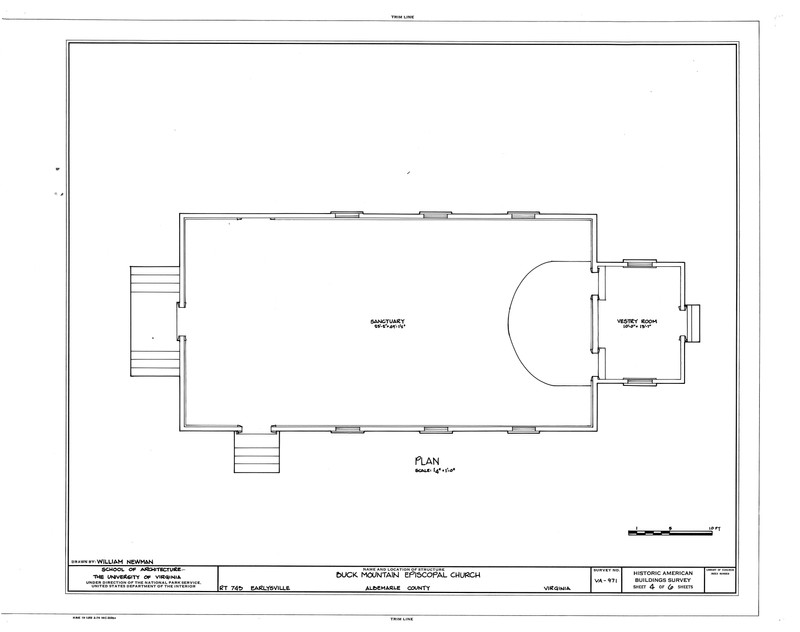Buck Mountain Episcopal Church
Introduction
Text-to-speech Audio
Buck Mountain Episcopal is a historic church located in Earlysville, Virginia. Built in the mid-1700s, it is one of the few surviving examples of the simple wooden Anglican churches that once dotted the landscape of Colonial Virginia. Following the Revolutionary War and the disestablishment of Anglicanism in the United States, the structure was acquired and rejuvenated by an Episcopalian congregation. Owing to the construction of the Buck Mountain Road, the church is not in its original location.
Images
Drawing of Buck Mountain Episcopal Church (exterior), from the Historic American Buildings Survey

Drawing of Buck Mountain Episcopal Church (side), from the Historic American Buildings Survey

Drawing of Buck Mountain Episcopal Church (interior), from the Historic American Buildings Survey

Backstory and Context
Text-to-speech Audio
When the settlers of Jamestown came to Virginia in 1607, so too did Anglicanism. The first meeting of the Virginia General Assembly in 1619 established the Church of England as the official religion of the colony. In response to a shortage of clergy, a lay-dominated vestry system was created in 1642/43 to assume necessary Episcopal functions, including the building of churches. Thus, on April 16, 1745, the Fredericksville parish vestry decided to build two churches "below the mountains" and one church "above the Little Mountains."1 Construction began on the latter church in 1747, five years after the formation of the parish. The first services were held on site July of the following year, and the church was formally accepted in 1750.
The end of the Revolutionary War signaled the end of Anglicanism in the United States. In 1779, the General Assembly passed an act stripping the Church of its power to administer levies, although the Fredericksburg Parish seems to have continued to lay levies until the Disestablishment Act of 1784. A church convention in Richmond in 1785 resulted in the formation of a self-governing Protestant Episcopal Church in the State of Virginia.
Following the disestablishment of the Anglican church, a Baptist Congregation used this building for services starting in 1801, changing its name to the Buckmountain Baptist Church. In 1833, an Episcopalian congregation reclaimed Buck Mountain Church, finally acquiring legal ownership of the property in 1844 (an event recorded in the Albemarle County Deed Book). The construction of the Buck Mountain Road, however, made it necessary to disassemble the building by 1859. The church was then relocated to its present location, approximately a mile east of where it originally sat.
Architecturally, the wooden church is simple in design. The structure is 50 by 26 feet. There seem to have been very few modifications since its initial construction (disregarding its relocation to a site near the village of Earlysville). Changes include replacement of the windows and some of the siding. A bell tower was built in the early 1930s, but the addition was destroyed by a storm in July 1997; its 60-pound bell, cast in Ohio, is now stored in the church basement. Instead of rebuilding the tower (which had been slated for removal anyway over concerns about its safety), the insurance payment was used to fund the construction of Deese Hall.
Today, the Buck Mountain Episcopal Church continues to offer services on Sundays and engage with the community. Deese Hall is used for meetings, Sunday School, and administrative space. The nearby Parish Hall is used as a food pantry and for community events. See the official website for event dates and times.
The end of the Revolutionary War signaled the end of Anglicanism in the United States. In 1779, the General Assembly passed an act stripping the Church of its power to administer levies, although the Fredericksburg Parish seems to have continued to lay levies until the Disestablishment Act of 1784. A church convention in Richmond in 1785 resulted in the formation of a self-governing Protestant Episcopal Church in the State of Virginia.
Following the disestablishment of the Anglican church, a Baptist Congregation used this building for services starting in 1801, changing its name to the Buckmountain Baptist Church. In 1833, an Episcopalian congregation reclaimed Buck Mountain Church, finally acquiring legal ownership of the property in 1844 (an event recorded in the Albemarle County Deed Book). The construction of the Buck Mountain Road, however, made it necessary to disassemble the building by 1859. The church was then relocated to its present location, approximately a mile east of where it originally sat.
Architecturally, the wooden church is simple in design. The structure is 50 by 26 feet. There seem to have been very few modifications since its initial construction (disregarding its relocation to a site near the village of Earlysville). Changes include replacement of the windows and some of the siding. A bell tower was built in the early 1930s, but the addition was destroyed by a storm in July 1997; its 60-pound bell, cast in Ohio, is now stored in the church basement. Instead of rebuilding the tower (which had been slated for removal anyway over concerns about its safety), the insurance payment was used to fund the construction of Deese Hall.
Today, the Buck Mountain Episcopal Church continues to offer services on Sundays and engage with the community. Deese Hall is used for meetings, Sunday School, and administrative space. The nearby Parish Hall is used as a food pantry and for community events. See the official website for event dates and times.
Sources
1. Bauer, Dan & Eddins, Jim. "Buck Mountain Church History." Buck Mountain Episcopal Church. Accessed January 9, 2017. http://buckmountainchurch.org/content.cfm?id=320.
"Buck Mountain Episcopal Church, State Route 743, Earlysville, Albemarle County, VA." Library of Congress. Accessed January 9, 2017. http://www.loc.gov/pictures/item/va0063/.
"Buck Mountain Episcopal Church, State Route 743, Earlysville, Albemarle County, VA." Library of Congress. Accessed January 9, 2017. http://www.loc.gov/pictures/item/va0063/.
